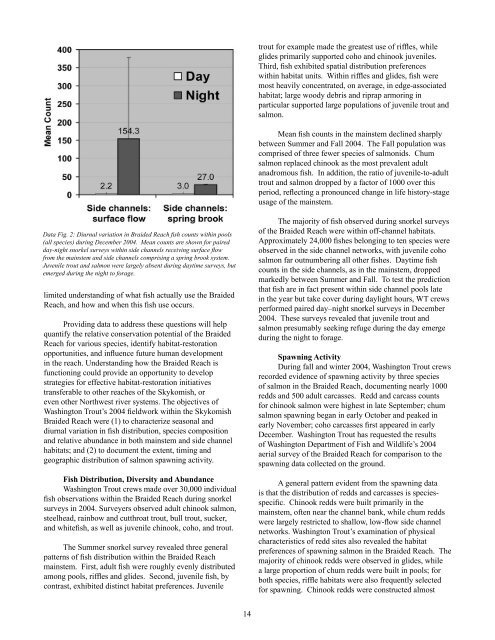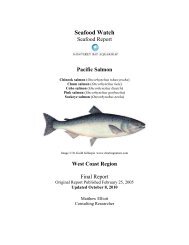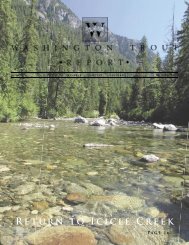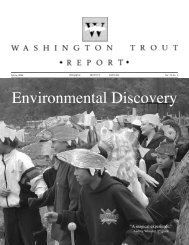Whidbey Island Near Shore Research Project
Washington Trout Report - Wild Fish Conservancy
Washington Trout Report - Wild Fish Conservancy
- No tags were found...
Create successful ePaper yourself
Turn your PDF publications into a flip-book with our unique Google optimized e-Paper software.
trout for example made the greatest use of riffles, while<br />
glides primarily supported coho and chinook juveniles.<br />
Third, fish exhibited spatial distribution preferences<br />
within habitat units. Within riffles and glides, fish were<br />
most heavily concentrated, on average, in edge-associated<br />
habitat; large woody debris and riprap armoring in<br />
particular supported large populations of juvenile trout and<br />
salmon.<br />
Mean fish counts in the mainstem declined sharply<br />
between Summer and Fall 2004. The Fall population was<br />
comprised of three fewer species of salmonids. Chum<br />
salmon replaced chinook as the most prevalent adult<br />
anadromous fish. In addition, the ratio of juvenile-to-adult<br />
trout and salmon dropped by a factor of 1000 over this<br />
period, reflecting a pronounced change in life history-stage<br />
usage of the mainstem.<br />
Data Fig. 2: Diurnal variation in Braided Reach fish counts within pools<br />
(all species) during December 2004. Mean counts are shown for paired<br />
day-night snorkel surveys within side channels receiving surface flow<br />
from the mainstem and side channels comprising a spring brook system.<br />
Juvenile trout and salmon were largely absent during daytime surveys, but<br />
emerged during the night to forage.<br />
limited understanding of what fish actually use the Braided<br />
Reach, and how and when this fish use occurs.<br />
Providing data to address these questions will help<br />
quantify the relative conservation potential of the Braided<br />
Reach for various species, identify habitat-restoration<br />
opportunities, and influence future human development<br />
in the reach. Understanding how the Braided Reach is<br />
functioning could provide an opportunity to develop<br />
strategies for effective habitat-restoration initiatives<br />
transferable to other reaches of the Skykomish, or<br />
even other Northwest river systems. The objectives of<br />
Washington Trout’s 2004 fieldwork within the Skykomish<br />
Braided Reach were (1) to characterize seasonal and<br />
diurnal variation in fish distribution, species composition<br />
and relative abundance in both mainstem and side channel<br />
habitats; and (2) to document the extent, timing and<br />
geographic distribution of salmon spawning activity.<br />
Fish Distribution, Diversity and Abundance<br />
Washington Trout crews made over 30,000 individual<br />
fish observations within the Braided Reach during snorkel<br />
surveys in 2004. Surveyers observed adult chinook salmon,<br />
steelhead, rainbow and cutthroat trout, bull trout, sucker,<br />
and whitefish, as well as juvenile chinook, coho, and trout.<br />
The Summer snorkel survey revealed three general<br />
patterns of fish distribution within the Braided Reach<br />
mainstem. First, adult fish were roughly evenly distributed<br />
among pools, riffles and glides. Second, juvenile fish, by<br />
contrast, exhibited distinct habitat preferences. Juvenile<br />
The majority of fish observed during snorkel surveys<br />
of the Braided Reach were within off-channel habitats.<br />
Approximately 24,000 fishes belonging to ten species were<br />
observed in the side channel networks, with juvenile coho<br />
salmon far outnumbering all other fishes. Daytime fish<br />
counts in the side channels, as in the mainstem, dropped<br />
markedly between Summer and Fall. To test the prediction<br />
that fish are in fact present within side channel pools late<br />
in the year but take cover during daylight hours, WT crews<br />
performed paired day–night snorkel surveys in December<br />
2004. These surveys revealed that juvenile trout and<br />
salmon presumably seeking refuge during the day emerge<br />
during the night to forage.<br />
Spawning Activity<br />
During fall and winter 2004, Washington Trout crews<br />
recorded evidence of spawning activity by three species<br />
of salmon in the Braided Reach, documenting nearly 1000<br />
redds and 500 adult carcasses. Redd and carcass counts<br />
for chinook salmon were highest in late September; chum<br />
salmon spawning began in early October and peaked in<br />
early November; coho carcasses first appeared in early<br />
December. Washington Trout has requested the results<br />
of Washington Department of Fish and Wildlife’s 2004<br />
aerial survey of the Braided Reach for comparison to the<br />
spawning data collected on the ground.<br />
A general pattern evident from the spawning data<br />
is that the distribution of redds and carcasses is speciesspecific.<br />
Chinook redds were built primarily in the<br />
mainstem, often near the channel bank, while chum redds<br />
were largely restricted to shallow, low-flow side channel<br />
networks. Washington Trout’s examination of physical<br />
characteristics of redd sites also revealed the habitat<br />
preferences of spawning salmon in the Braided Reach. The<br />
majority of chinook redds were observed in glides, while<br />
a large proportion of chum redds were built in pools; for<br />
both species, riffle habitats were also frequently selected<br />
for spawning. Chinook redds were constructed almost<br />
14






